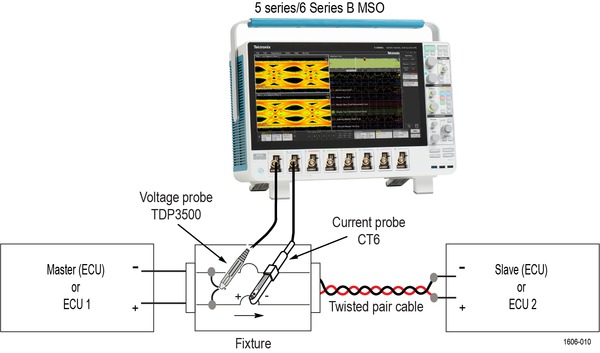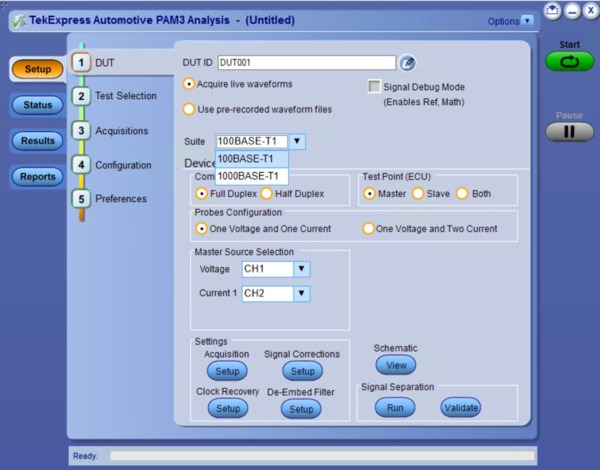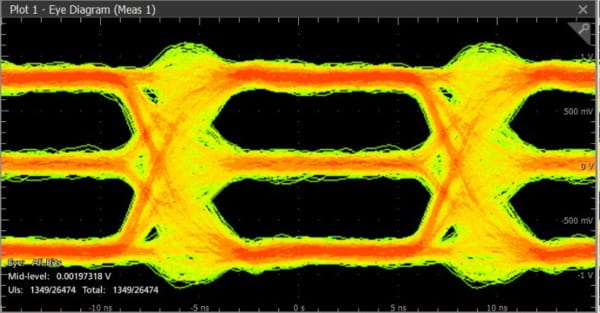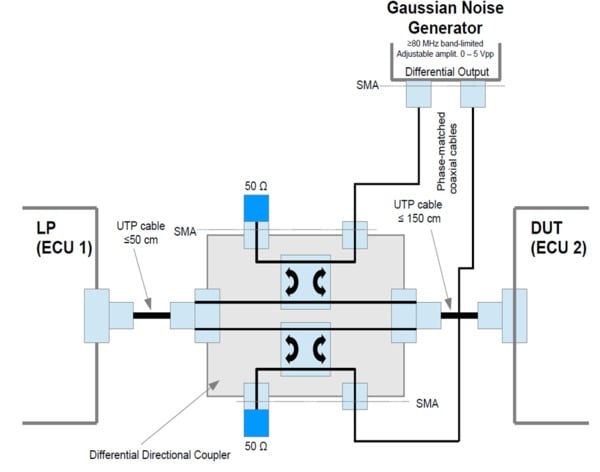Contact us
Live Chat with Tek representatives. Available 6:00 AM - 4:30 PM
Call us at
Available 6:00 AM – 5:00 PM (PST) Business Days
Download
Download Manuals, Datasheets, Software and more:
Feedback
TekExpress Automotive Ethernet 100BASE-T1 and 1000BASE-T1 Signal Separation and PAM3 Analysis
Signal Integrity and Protocol Decode Datasheet

For Automotive Ethernet designing, testing, and debugging, Tektronix offers the comprehensive PAM3 Signal Analysis, Signal Quality test, and Protocol Decode testing solution.
Key features
- Signal Separation software: Award winning Tektronix Signal Separation software (Patent pending) lets you perform Signal Analysis or Protocol Decode without affecting the ECU system or installing a direct coupler by cutting the Ethernet cable. Signal separation is available for 100BASE-T1 and 1000BASE-T1 Automotive Ethernet.
- PAM3 Analysis: You can perform PAM3 Analysis to measure Eye Opening, Eye Mask testing, Jitter Separation, and BER plot in real ECU environment for the Master ECU or Slave ECU.
Enhanced Clock Recovery: Software clock recovery offers the industry's most robust clock recovery capability even from heavily impaired signals.
- Signal Quality Test: You can perform Open Alliance TC8 Signal Quality test with an Eye Diagram instead of a Signal Quality Index (SQI) value. The Eye Diagram in a noise condition provides better insight compared to the SQI value.
- Automotive Ethernet Protocol Decode: The Tektronix Signal Separation solution enables decoding of 100BASE-T1 Automotive Ethernet using the Signal Separation technique. You can perform accurate protocol decoding without breaking the cable.
- Live Eye diagram and Protocol Decode: You can visualize eye diagrams and protocol decode in real time, to study the effects of noise and perform timing measurements.
- Noise Analysis for In-Car testing: Plot eye diagrams and perform noise analysis to study the effect of noise on your receiver.
- Comprehensive Reporting: Automated reporting with Pass/Fail screenshots of the waveforms.
Automotive Ethernet overview
The Autonomous Driving Assistance System (ADAS) and human-to-machine subsystems generate vast amount of data to transport through a vehicle. Requirements for greater integration between vehicle subsystems are driving fundamental architectural changes, moving from simple ring networks to more complex topologies, including gateways connected to an Automotive Ethernet backbone.
Automotive Ethernet 1000BASE-T1 (802.3bpTM) and 100BASE-T1 (802.3bwTM) standards are among the fastest growing technologies for in-vehicle networks.
Automotive Ethernet provides significant advantages including:
PAM3 modulation supports high data rates and reliability
Unshielded and single twisted-pair cabling lowers cost and weight
Full-duplex communication allows devices to send and receive simultaneously on a link
Proven IT technology with reliable data throughput for safety critical systems
The integration of Automotive Ethernet technology is placing greater demands on comprehensive design validation to ensure interoperability and reliability between multiple ECUs and devices that will perform reliability in demanding environments. To meet strict compliance tests and have greater confidence in design margins operating under real world conditions, a complete testing solution is a necessity.
Automotive Ethernet and Full Duplex Communication

Automotive Ethernet operates as a full-duplex communication link over a twisted pair cable. The full-duplex communication along with PAM3 signaling adds complexity in validating the ECUs in the real world conditions.
To perform Signal Analysis over the link and Protocol Decode in a real system environment, automobile designers need to look at each link separately which requires the user to separate the signals before performing analysis. Unfortunately, many of the current testing solutions requires breaking the Automotive Ethernet cable to perform the testing. This introduces additional test challenges. The Tektronix PAM3 Signal Analysis application solves these issues with a comprehensive testing solution.
Use Cases
| Customer | DUT Type | Job to be done |
|---|---|---|
| PHY Silicon companies | Automotive Ethernet PHY Silicon |
|
| Automotive T1 companies, Cable manufacturer | ECU |
|
System: ECU to ECU, ECU to Sensor, Cable |
| |
| Performance Test |
| |
| Automotive OEM | In-Car Testing |
|
Reliability is critical in automotive electronics. Data must be transferred between sensors and ECUs without errors, under all conditions. As data rates increase, signal integrity analysis becomes more important to help one understand the effects of noise, cable length, cable layout, and other factors.
Signal separation
As Automotive Ethernet is full-duplex communication, both ECUs can send and receive the data simultaneously on the same link. To perform Signal Analysis or Protocol Decode in a real system environment, the traffic of the Master and the Slave ECU needs to be separated.
One approach to separate the full-duplex signal is to use a Directional coupler. This approach requires the user to cut the cables to install the Directional coupler. Using a Directional coupler adds its own Insertion loss and Return loss which can negatively impact the testing results. While it is possible to compensate for the loss at the setup level, the directional coupler approach disturbs the system, making it difficult to know if the errors are introduced by the additional hardware.
To avoid erroneous measurements, Tektronix award winning Signal Separation solution separates the full-duplex signal using the advanced software. The Signal Separation solution accesses the voltage and current waveform from either the Master or Slave Test point, or from both sides simultaneously using the Tektronix proprietary Signal Separation algorithm. This method displays true ECU signals (Master and Slave) without impacting the ECU system.


The Tektronix Signal Separation software can separate full-duplex traffic for Automotive Ethernet 100BASE-T1 and 1000BASE-T1 testing real ECU test conditions, including different cable lengths and types, different ECUs, ECU-to-Switch conditions, different noise conditions, and inside the car with the Automotive Ethernet connectivity.
Tektronix Signal Separation solution earned the top honors in the Test and measurement category in the second-year Leadership in Engineering Achievement Program (LEAP) Awards.
Refer to the Signal Access section to learn more about how to connect the voltage and current probes for different testing situations.

Ease of use: It is easy to connect the voltage and current probes without disturbing the cables. You can directly connect probes to the ECU connector. If a fixture is needed to access signals, Tektronix can provide assistance to design a fixture to connect the voltage and current probes.
Live Signal Separation: Once the settings are configured, you can run signal separation in live mode. You can keep the oscilloscope in continuous RUN or Single RUN mode to study the eye diagram and the effect of noise in runtime mode.
Automation: The TekExpress Ethernet Signal Separation and PAM3 Analysis software is a completely Automated test solution. Using the Tektronix TekExpress automation platform, its user interface design guides you step-by-step to configure the system and perform analysis.

PAM3 Analysis: The following three levels of PAM3 introduce additional complexity in signaling and place new demands on the test methodology. The PAM3 analysis tool offers several measurement and visualization capabilities to make the task of validating Automotive Ethernet PAM3 designs more efficient.
PAM3 Measurement configuration: The configuration panel within the PAM3 analysis tool let you configure most elements for a PAM3 analysis run. The setup tool includes measurement source selection, clock recovery, and threshold configuration.

Clock recovery: The configurable PLL (Phase-Locked Loop) clock recovery function reliably extracts the symbol clock, even with highly impaired signals, and exports the reconstructed clock waveform to a reference channel where it is viewed.

Equalizer and Pulse shaping: Automotive Ethernet uses proprietary receiver equalizer and pulse shaping filters. To mimic actual transmitter and receiver, the Tektronix signal separation solution offers you a defined equalizer and pulse shaping filter. You can now accurately perform eye diagram testing for Automotive Ethernet standards using self-defined coefficients for equalizer and pulse shape filters.



PAM3 measurements: The PAM3 analysis package provides a comprehensive set of measurements that offer greater insight into signal characteristics, speeding up validation or characterization of PAM3 designs with different cable length, noise conditions ECU configurations, and so on.

| Measurement group | Measurements |
|---|---|
| Eye diagram | Eye Height |
| Eye Width | |
| Eye Mask | |
| Jitter | Random Jitter (DD) |
| Deterministic Jitter (DD) | |
| Total Jitter @ BER | |
| Timing | Rise Time (Symbol 0->1, -1->1 and -1->0) |
| Fall time (Symbol 0->-1, 1->0 and 1 -> -1) | |
| PAM3 Modulation | Linearity |
Visualization: A comprehensive set of plots let you visualize the measurement data. The plots provide insight into the signal characteristics and are useful for debugging.
The plot tool set enables interaction with the plots, helping you to focus on an area of interest for closer examination and further analysis.





Multi-run for Signal Characterization: The PAM3 Analysis solution lets you to run the measurements multiple times to characterize ECU with different conditions. You can also set the PAM3 Automation software to pause on failure to debug the issue. All the waveforms from different runs can be saved in a folder to analyze and debug later.

Pass fail reports
Creating the test report documentation is quick and easy with a summary report in MHT or PDF format. The report provides Pass/Fail status and is automatically generated after the test execution is completed. The report includes test configuration details, waveform plots, oscilloscope displays, and margin analysis, to provide more insights into your design.

Signal quality test
The Open Alliance TC8 Signal quality test requires adding Gaussian noise on the Ethernet cable to check the noise level at which the ECU full-duplex communication breaks. While users can read the SQI register value from the Automotive Ethernet PHY to find out Signal Quality Index, the SQI value will not represent the Eye diagram or any debug tools to find out the root cause of the problem.

With Tektronix Signal Separation, you can separate the full-duplex signal and display the Eye diagrams to debug further. The PAM3 Analysis tools let you debug the cause of the link failure. You can also perform a Protocol Decode test to check at what point the link fails.
Cable Performance Test, Production Pass/Fail Test, and ECU signal Integrity test: The Open Alliance has defined Automotive Ethernet cable tests covering Return Loss and Insertion loss. It is important to know how different cable lengths and cable types affect the Automotive Ethernet signal integrity.
Tektronix Signal Separation software lets you plot the Eye diagram for different cable lengths and cable types to compare their performance.

Mask test: You can define your own mask to perform Eye Mask testing for the different cable lengths, production pass/fail testing, or ECU performance testing. The TekExpress solution also provides predefined masks that can be used for your requirements.

Protocol Decode
The Tektronix Protocol Decode solution does not require a directional coupler to separate the traffic. Without disturbing the system, you can perform Protocol Decode at the design level, for ECU development, or for system debug for in-car testing. You can also perform Protocol Decode on multiple ECUs simultaneously to perform timing analysis or to debug. Users can define various protocol level conditions to stop the acquisition and debug on a specific event.

6 Series B MSO Oscilloscope

With up to 10 GHz analog bandwidth, 50 GS/s sample rates, lowest noise and highest resolution, the 6 Series B MSO oscilloscope has the performance you need to capture waveforms with the best possible signal fidelity.
At the heart of the 6 Series B MSO oscilloscope are 12-bit analog-to digital converters (ADCs) that provide 16 times the vertical resolution of traditional 8-bit ADCs. This resolution, combined with an extremely low-noise front end, allows you capture small signal details even on relatively large signals.
TekScope PC Waveform Analysis Software
The Automotive Ethernet Signal Separation, PAM3 Analysis, and Protocol decode are available on PC-based TekScope advanced packages. Learn more about this at
https://scope.tekcloud.com/#/packages

Probing and test fixtures
For direct probing of a DUT, a differential voltage probe with a bandwidth of ≥ 2 GHz and a current probe with a bandwidth of ≥ 1 GHz are recommended for Automotive Ethernet 1000BASE-T1. For Automotive Ethernet 100BASE-T1, a voltage probe with a bandwidth of >1 GHz and a current probe with a bandwidth of >120 MHz are recommended. The Tektronix TDP3500 differential voltage probe and CT6 current probe are recommended for 1000BASE-T1. Similarly, TDP1500 or TDP3500 differential voltage probe and TCP0030A or P6022 current probe are recommended for 100BASE-T1.
Accessing signals at the ECU level may require a fixture for signal separation. Contact Tektronix to learn more about custom fixture design for ECUs.
Ordering information
- Required hardware
5 Series MSO oscilloscope (2 GHz Option 5-BW-2000) or 6 Series B MSO oscilloscope with minimum bandwidth of 2 GHz (Option 6-BW-2500, 6-BW-4000, 6-BW-6000, 6-BW-8000, 6-BW-10000) for 1000BASE-T1
5 Series MSO oscilloscope (1 GHz Option 5-BW-1000, 5-BW-2000 or 6 Series B MSO oscilloscope with minimum bandwidth of 1 GHz (Option 6-BW-1000, 6-BW-2500, 6-BW-4000, 6-BW-6000, 6-BW-8000, 6-BW-10000) for 100BASE-T1
Option 5-WIN, Opt. 6-WIN or SUP5-WIN, SUP6-WIN (removable SSD with Microsoft Windows 10 operating system)
- Required software
Perpetual License:
Option 5-AUTOEN-SS or 6-AUTOEN-SS (Automotive Ethernet Signal Separation)
Option 5-PAM3 or 6-PAM3 (PAM3 Analysis)
Option 5-DJA or 6-DJA (Advanced Jitter and Eye Analysis)
Option 5-SRAUTOEN1 or 6-SRAUTOEN1 (100BASE-T1 Protocol Decode)
- Recommended options
Option 5-CMAUTOEN or 6-CMAUTOEN (TekExpress 100BASE-T1/1000BASE-T1 Automotive Ethernet Compliance)
Option 5-AUTO-BND or 6-AUTO-BND (Automotive Ethernet Compliance, Signal Separation, PAM3 Analysis (requires Option 5-DJA), 100BASE-T1 Serial Decode (bundle option))
Option 5-RL-125M or SUP5-RL-125M (adds 125 M record length)
Option 5-SRAUTO or 6-SRAUTO, SUP5-SRAUTO or SUP6-SRAUTO (adds CAN, CAN FD, LIN, FlexRay Serial Bus Trigger and Decode)
Option 5-SREMBD or 6-SREMBD, SUP5-SREMBD or SUP6-SREMBD (adds I2C, SPI Serial Bus Trigger and Decode)
- Probing
- TDP1500 or TDP3500 differential probe(s), TCP0030A (100BASE-T1) or P6022 (100BASE-T1) or CT6 (100/1000BASE-T1) current probe(s)
- Recommended test fixtures
Contact Tektronix for ECU dependent fixtures
- TekScope
Opt TEKSCOPE PAM3 BND 1Y PAM3 / Signal Separation / 100BT1 Ethernet Protocol Automotive Solution (1 year subscription)
Opt TEKSCOPE PAM3 BND 3Y PAM3 / Signal Separation / 100BT1 Ethernet Protocol Automotive Solution (3 year subscription)
- Recommended extras
External PC monitor
USB keyboard
USB mouse





